
This framework was first circulated to FundsIndia shoppers on 01-Mar-24, as we exited from our Small Cap Tactical name
Are Small caps in a bubble?
Right here is our 6 lens framework (Worth Cycle – Lengthy & Quick, Valuations, Flows & Sentiments, Earnings Progress Atmosphere, Previous Returns) to judge the place we’re within the small cap cycle.
As an alternative of taking a unidimensional view, the try is to view the small cap cycle from 6 totally different vantage factors to establish the ‘elephant’!

What qualifies as a ‘Bubble’ in small caps?
The valuations are so excessive that even after a 25% correction, it will nonetheless stay costly and doesn’t make sense to enter!
Why 25% correction?
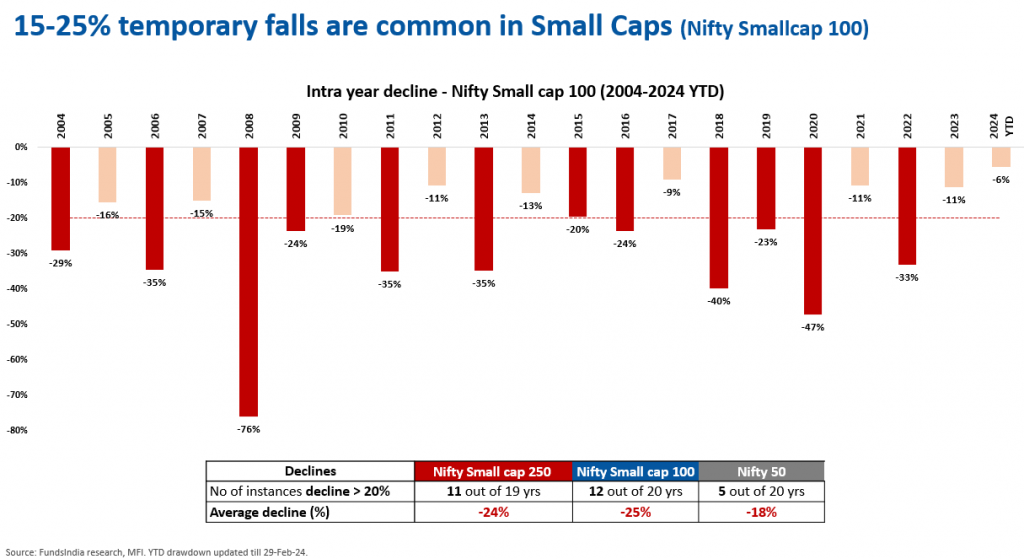
6 Lens Framework to Analyse Small Cap Phase
LENS 1 – LONG PRICE CYCLE: Lengthy Cycle Indicator is flashing ‘purple’ – near historic highs
Small Cap Worth Cycle – Present rally at 5.1x occasions from 2020 lows
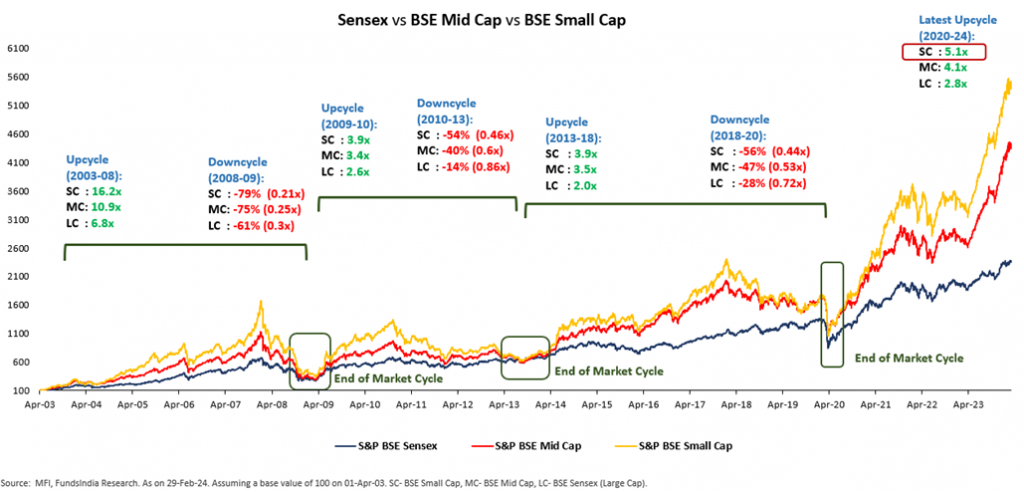
Giant, Mid & Small Caps are inclined to converge over lengthy cycles, however small caps do disproportionately nicely in upcycles and vice versa. Presently, Small Caps have seen a pointy rally of 5.1x from the bottoms in Mar-2020.
BSE Small Cap to BSE Sensex ratio near 16 12 months highs
Traditionally at any time when this ratio has crossed 2.0x the small caps section has fallen within the brief time period. Small Cap to Giant Cap ratio (at present at 2.3x) has crossed 2018 peak ranges and is transferring nearer to 2008 peaks indicating ‘excessive threat’. This necessitates warning on the present juncture.
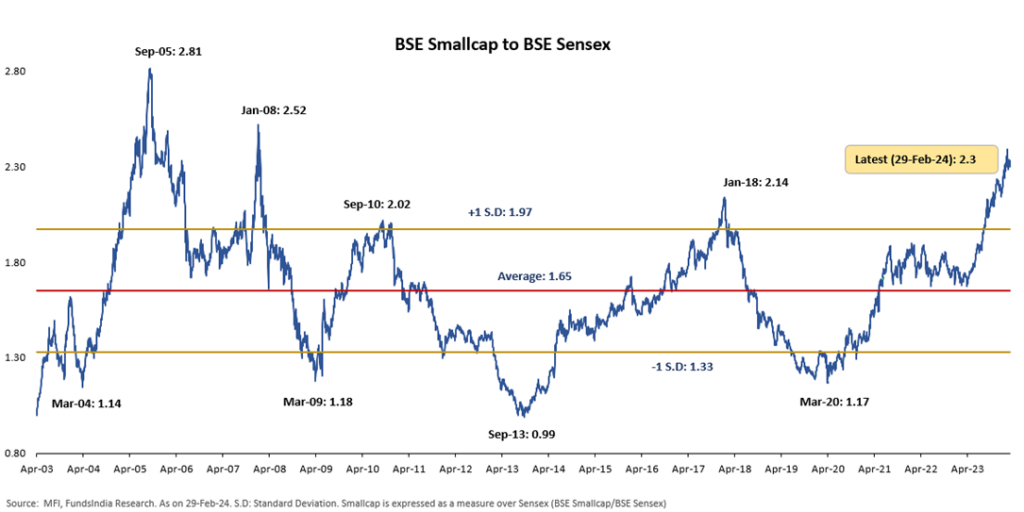
LENS 2 – SHORT PRICE CYCLE: Rally might proceed for some extra time (6-12 months)
Up to now cycles, common time from the underside to peak is ~1.5 to 2 years and common upside is ~2-3x.
Present rally is at 11 months with 1.8x returns indicating scope for additional rally. Utilizing historical past as a information, brief value cycle signifies that the rally might proceed for 6-12 months.
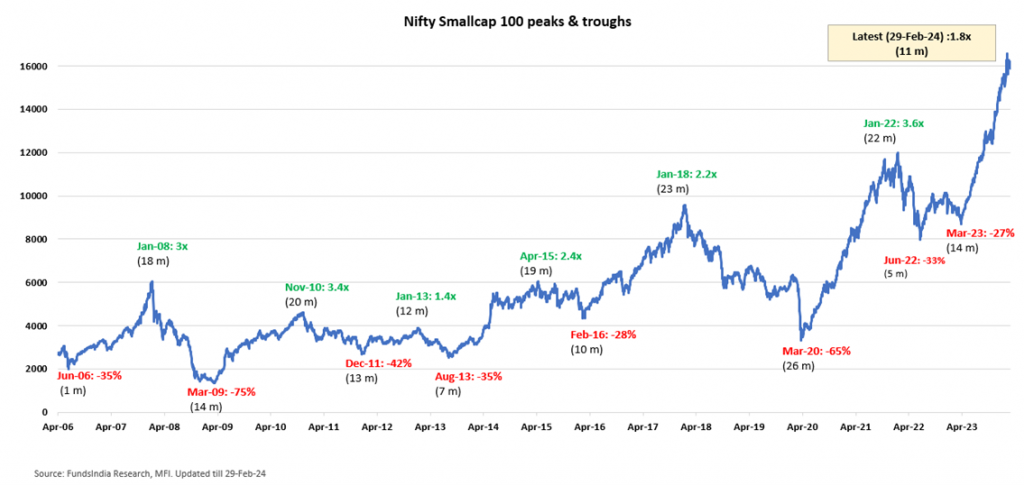
LENS 3 – VALUATIONS: Valuations have turn out to be “Costly”
Share of Small Cap Market Capitalisation within the General Market Capitalisation is at larger ranges (~17.2%).
At any time when the share of Small Cap MCAP within the General MCAP crosses 15%, it warrants warning. Presently the share is at 17.2%. The revenue share of Small Caps within the General Market remains to be at decrease ranges (~12%) as in comparison with the share of Market Cap.

Small Caps are at present buying and selling at a big premium over Giant Caps
Worth to Earnings of Small Cap Indices are buying and selling at traditionally larger premiums over Giant Caps. The present premium of Nifty Small Cap 250 PE vs Nifty 50 PE is at 27%, indicating costly valuations.

LENS 4 – SENTIMENTS & FLOWS – Sentiments point out ‘Greed’ within the Small Cap house
There was a big leap in Small Cap inflows and an growing variety of new folios beginning Might-23.

Nifty 100 Buying and selling quantity as a % of Nifty 500 has decreased indicating ‘excessive threat taking’ sentiments

Google traits present vital Curiosity within the Small Cap house
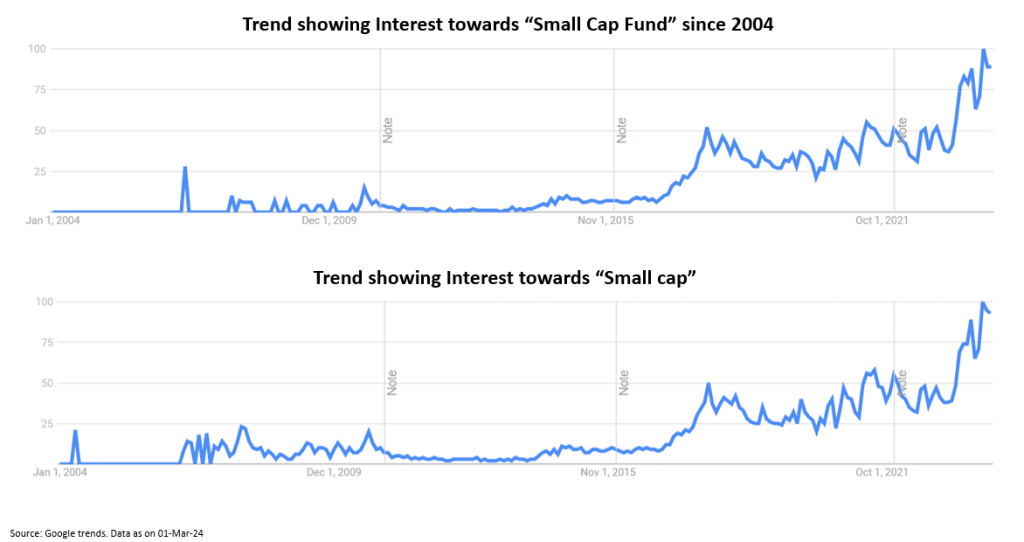
Lot of latest Small Cap Funds are getting launched and garnering excessive AUMs regardless of excessive valuations indicating excessive investor curiosity


Checklist of New Small Cap NFOs launched lately:
- Mirae Asset Nifty Smallcap 250 Momentum High quality 100 ETF Fund of Fund (15-Feb-24)
- Groww Nifty Smallcap 250 Index Fund (09-Feb-24)
- Bandhan Nifty Small Cap 250 Index Fund (12-Dec-23)
- Motilal Oswal Small Cap Fund (05-Dec-23)
- DSP Nifty Smallcap 250 High quality 50 Index fund (05-Dec-23)
- Quantum Small Cap Fund (16-Oct-23)
- Baroda BNP Paribas Small Cap Fund (06-Oct-23)
- Motilal Oswal Nifty Micro Cap 250 Index Fund (15-Jun-23)
Whereas on the opposite facet, some cautious Fund Managers have stopped accepting flows of their Small Cap Funds citing considerations on Valuations and Flows


Mutual Funds regulator SEBI raised considerations over “froth increase within the Small and Midcap section” amid persevering with flows in these segments.
Trade physique Affiliation of Mutual Funds in India (AMFI) in a latest letter (dated 27-Feb-2024) has requested mutual funds to place in place safeguards to guard the pursuits of all traders in mid- and small-cap funds. AMFI despatched this letter after market regulator Securities and Change Board of India (SEBI) raised considerations of ‘froth increase in small and midcap segments’ amid persevering with flows in mid- and small-cap funds.
AMFI has suggested mutual funds to take “applicable and proactive” measures corresponding to moderating inflows, portfolio rebalancing, conducting stress assessments on sharp redemption chance and many others to shield traders from first-mover benefit of redeeming traders in case of sharp redemptions.

LENS 5 – PAST PERFORMANCE – Flashing “RED” Sign
Very Excessive Previous Efficiency – 1Y, 3Y, 5Y, 7Y and 10Y annual returns are just like previous Bubble markets -> Contra Indicator – indicating excessive optimism
- Throughout previous bubble markets, the final 1Y returns have been normally above 50%. Presently, the 1Y returns for Nifty Small Cap 100 TRI is at 75%.
- 3Y, 5Y and 7Y are within the 20-30% vary, which has similarities to 20-25% vary seen previously bubbles.

5Y Rolling return Outperformance of Small Caps vs Giant Caps are nearer to historic highs
The 5 12 months rolling outperformance of Nifty Small Cap 250 TRI vs Nifty 50 TRI is at 9.4% – nearer to 2018 peak ranges (11.4% outperformance vs Nifty 50 TRI).

LENS 6 – FUNDAMENTALS: Fundamentals are strong and market setting is beneficial for Small Caps
Broader markets anticipate sturdy earnings development over the following 2-3 years. This augurs nicely for Small Caps as they have an inclination to develop sooner than giant caps in such environments.

Small Caps normally carry out nicely in a powerful earnings cycle part. Greater Valuations of Small Caps vs Giant Caps is pushed by Greater earnings development expectations. BSE Small Cap 250 is estimated to develop at ~25% CAGR over FY23-FY25 (larger than BSE 100 which is anticipated to develop at ~20% CAGR)

Robust Steadiness Sheets – Debt to Fairness ranges for Small caps at historic lows
Debt to Fairness ratio for small caps has decreased to 0.3x in FY23 from 0.8x in FY15 – the bottom within the final 15 years

Summing it up
-> 4 of our whole 6 indicators which we use to trace the small cap section are flashing warning indicators:
- Detrimental Alerts (Complete 4):
- Lengthy cycle reveals that Small Caps are shut to historic peak ranges
- Valuations have turn out to be ‘Costly’
- Sentiments are Euphoric – vital leap in small cap fund inflows (primarily from mutual funds) + few funds closing for recent inflows + Lot of New NFO launches
- Previous efficiency – contra indicator – very excessive previous returns warrants warning
- Optimistic Alerts (Complete 2):
- Quick cycle – Traditionally, the Small Cap brief cycle from backside to peak lasted for ~1.5 to 2 years. The present small cap rally had began from Mar-2023. If we use earlier brief cycles as a tough information, the present rally might proceed until second half of FY25 (Oct-24 to Mar-25)
- Robust Fundamentals for Small Caps – Bettering Profitability (ROE) + Greater Earnings Progress + Robust stability sheets (low debt)
- Set off to Monitor:
- SEBI’s actions to average flows into small and midcaps
- Mutual Fund Stress Check Outcomes
- Liquidity threat in small cap funds/PMS
View -> Time to be CAUTIOUS!
What does this imply in ENGLISH?
Small Caps are usually not in a bubble (learn as probabilities of a giant 50-70% fall could be very low) – as
- Fundamentals stay sturdy – Strong earnings development + Wholesome stability sheets
- Quick Worth Cycle Lens signifies additional legs to the rally
Nonetheless, the chances of a short lived 20-30% correction has considerably elevated at this juncture as Lengthy Worth Cycle, Valuations, Flows & Sentiments, Previous Efficiency lens – all indicators are flashing RED.
What do you have to do?
- Rebalance your Small Cap publicity again to unique allocation.
- If overexposed, scale back Small Cap publicity to <15- 20% of your Fairness portfolio (as per your threat profile)
- Proceed your SIPs provided that your time-frame is >7 years
- For Incremental Investments: Keep away from Giant Lumpsum Allocations
Different articles you might like
Publish Views:
5,272



